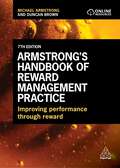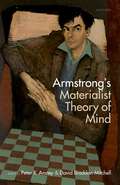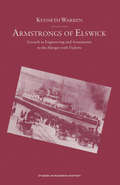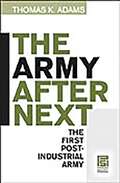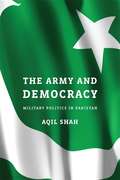- Table View
- List View
Armstrong's Handbook of Management and Leadership for HR: Developing Effective People Skills for Better Leadership and Management
by Michael ArmstrongTo make an effective contribution, HR specialists have to be good at management, leadership and developing both themselves and others. They also need to be aware of the management and business considerations that affect their work. Armstrong's Handbook of Management and Leadership for HR provides guidance on the processes of management and leadership with particular reference to what HR managers and aspiring managers need to know and do to make a difference. Written by renowned human resources expert and bestselling author Michael Armstrong, Armstrong's Handbook of Management and Leadership for HR covers in one volume the 'Leading, Managing and Developing People' and 'Developing Skills for Business Leadership' Chartered Institute of Personnel and Development (CIPD) modules. It includes numerous practical features such as case studies, practitioner interviews, exercises and clear learning objectives to aid learning. This is the essential book for HR students and professionals looking to broaden their skills and understanding relating to management and leadership. Online supporting resources include lecture slides, an instructor's manual, a student's manual and a literature review.
Armstrong's Handbook of Performance Management: An Evidence-Based Guide to Delivering High Performance
by Michael ArmstrongArmstrong's Handbook of Performance Management addresses all areas of performance management, from performance pay and giving feedback to managing underperformers and having difficult conversations, so organizations can optimize staff performance. This fully updated and restructured 6th edition analyzes traditional as well as the latest developments in performance management including the shift from ratings and annual reviews. Veteran HR expert Michael Armstrong examines where these new approaches should be embraced and where traditional methods of performance management may be preferable. Packed with examples, exercises, checklists and new case studies from organizations such as Microsoft, IBM and Expedia, this book remains the most authoritative and engaging textbook on performance management. Supporting online resources for Armstrong's Handbook of Performance Management include an instructor's manual, a student's manual, lecture slides, a glossary of terms and a literature review.
Armstrong's Handbook of Performance Management: An Evidence-Based Guide to Delivering High Performance
by Michael ArmstrongArmstrong's Handbook of Performance Management addresses all areas of performance management, from performance pay and giving feedback to managing underperformers and having difficult conversations, so organizations can optimize staff performance. This fully updated and restructured 6th edition analyzes traditional as well as the latest developments in performance management including the shift from ratings and annual reviews. Veteran HR expert Michael Armstrong examines where these new approaches should be embraced and where traditional methods of performance management may be preferable. Packed with examples, exercises, checklists and new case studies from organizations such as Microsoft, IBM and Expedia, this book remains the most authoritative and engaging textbook on performance management. Supporting online resources for Armstrong's Handbook of Performance Management include an instructor's manual, a student's manual, lecture slides, a glossary of terms and a literature review.
Armstrong's Handbook of Performance Management: An Evidence-Based Guide to Delivering High Performance
by Michael ArmstrongArmstrong's Handbook of Performance Management addresses all areas of performance management, from performance pay and giving feedback to managing underperformers and having difficult conversations, so organizations can optimize staff performance. This fully updated and restructured 6th edition analyzes traditional as well as the latest developments in performance management including the shift from ratings and annual reviews. Veteran HR expert Michael Armstrong examines where these new approaches should be embraced and where traditional methods of performance management may be preferable. Packed with examples, exercises, checklists and new case studies from organizations such as Microsoft, IBM and Expedia, this book remains the most authoritative and engaging textbook on performance management. Supporting online resources for Armstrong's Handbook of Performance Management include an instructor's manual, a student's manual, lecture slides, a glossary of terms and a literature review.
Armstrong's Handbook of Performance Management: An Evidence-Based Guide to Performance Leadership
by Michael ArmstrongOptimizing staff performance is a key component of achieving outstanding business results. The new edition of Armstrong's Handbook of Performance Management is an essential companion for improving employee and organizational performance.From performance pay and giving feedback to managing underperformers, this handbook addresses all areas of performance management to enable students and practitioners to understand how to assess, measure and improve performance.This updated seventh edition contains new chapters on the meaning and development of performance management and managing performance with a remote workforce. It also covers performance leadership and multi-source feedback. Packed with examples to show how the theory applies in practice and exercises to consolidate student learning, Armstrong's Handbook of Performance Management remains an indispensable and engaging resource for securing effective performance across all aspects of the organization. Supporting online resources include an instructor's manual, lecture slides, a glossary and a literature review
Armstrong's Handbook of Performance Management: An Evidence-Based Guide to Performance Leadership
by Michael ArmstrongOptimizing staff performance is a key component of achieving outstanding business results. The new edition of Armstrong's Handbook of Performance Management is an essential companion for improving employee and organizational performance.From performance pay and giving feedback to managing underperformers, this handbook addresses all areas of performance management to enable students and practitioners to understand how to assess, measure and improve performance.This updated seventh edition contains new chapters on the meaning and development of performance management and managing performance with a remote workforce. It also covers performance leadership and multi-source feedback. Packed with examples to show how the theory applies in practice and exercises to consolidate student learning, Armstrong's Handbook of Performance Management remains an indispensable and engaging resource for securing effective performance across all aspects of the organization. Supporting online resources include an instructor's manual, lecture slides, a glossary and a literature review
Armstrong's Handbook of Reward Management Practice: Improving Performance Through Reward
by Michael Armstrong Duncan BrownArmstrong's Handbook of Reward Management Practice is the definitive guide to understanding, developing and implementing effective reward strategies. It covers all the essential aspects of improving organizational, team and individual performance through reward processes, including financial and non-financial rewards, job evaluation, grade and pay structures, rewarding specific employee groups and ethical considerations. This revised and updated sixth edition incorporates the latest research and developments and contains updated coverage of equal pay and the gender pay gap, employee benefits and total reward and a new chapter on employee financial wellbeing.As with all of Armstrong's texts, Armstrong's Handbook of Reward Management Practice bridges the gap between academic and practitioner and is ideally suited to both HR professionals and those studying for HR qualifications, including master's degrees and the CIPD's intermediate and advanced level qualifications. Tips and checklists and can be found throughout, alongside case studies from organizations including General Motors, the UK National Health Service and Tesco. Online supporting resources include lecture slides and comprehensive handbooks for lecturers and students, which include learning summaries, discussion questions and exercises, literature reviews and glossaries.
Armstrong's Handbook of Reward Management Practice: Improving Performance Through Reward
by Michael Armstrong Duncan BrownArmstrong's Handbook of Reward Management Practice is the essential guide to comprehending, developing and implementing effective reward strategies. This updated seventh edition incorporates the latest research and developments within reward management, including the reward implications of Covid and the 'great resignation' and rewarding remote and hybrid workers. Revisions also contain updates on reward structures, equal pay, employee benefits including wellbeing benefits, total rewards and smart rewards. This book covers all the crucial aspects of improving organizational, team and individual performance through reward processes, including financial and non-financial rewards, job evaluation, grade and pay structures, rewarding specific employee groups and ethical considerations. Armstrong's Handbook of Reward Management Practice bridges the gap between the academic and practitioner and is ideally suited to both HR professionals and those studying for HR qualifications, including master's degrees and the CIPD's intermediate and advanced level qualifications. Tips and checklists and can be found throughout, alongside case studies from organizations including General Motors, and the UK National Health Service. Online supporting resources include lecture slides and comprehensive handbooks for both lecturers and students, which include learning summaries, discussion questions, literature reviews and glossaries.
Armstrong's Handbook of Reward Management Practice: Improving Performance Through Reward
by Michael Armstrong Duncan BrownArmstrong's Handbook of Reward Management Practice is the essential guide to comprehending, developing and implementing effective reward strategies. This updated seventh edition incorporates the latest research and developments within reward management, including the reward implications of Covid and the 'great resignation' and rewarding remote and hybrid workers. Revisions also contain updates on reward structures, equal pay, employee benefits including wellbeing benefits, total rewards and smart rewards. This book covers all the crucial aspects of improving organizational, team and individual performance through reward processes, including financial and non-financial rewards, job evaluation, grade and pay structures, rewarding specific employee groups and ethical considerations. Armstrong's Handbook of Reward Management Practice bridges the gap between the academic and practitioner and is ideally suited to both HR professionals and those studying for HR qualifications, including master's degrees and the CIPD's intermediate and advanced level qualifications. Tips and checklists and can be found throughout, alongside case studies from organizations including General Motors, and the UK National Health Service. Online supporting resources include lecture slides and comprehensive handbooks for both lecturers and students, which include learning summaries, discussion questions, literature reviews and glossaries.
Armstrong's Handbook of Strategic Human Resource Management: Improve Business Performance Through Strategic People Management
by Michael ArmstrongArmstrong's Handbook of Strategic Human Resource Management is a complete guide to integrating HR strategies with wider organizational goals and objectives approaches to achieve sustained competitive advantage. Supported by key learning summaries, source reviews and practical real-life examples from organizations including UNICEF and General Motors (GM), it provides coverage of HRM strategies in key areas of the function such as employee engagement, talent management and learning and development, as well as strategic HRM approaches in an international context. This fully revised seventh edition of Armstrong's Handbook of Strategic Human Resource Management contains new chapters on evidence-based strategic HRM, employee wellbeing strategies and HR analytics, as well as additional case studies and updated wider content to reflect the latest research and thinking. It remains an indispensable resource for both professionals and those studying HR qualifications, including undergraduate and masters degrees and the CIPD's advanced level qualifications. Online supporting resources include lecture slides and comprehensive handbooks for lecturers and students which include self-assessment questions, case study exercises, and a glossary and literature review.
Armstrong's Handbook of Strategic Human Resource Management (6th edition) (PDF)
by Michael ArmstrongStrategic human resource management has been taken up by academics, consultants and practitioners alike. However, the integration of human resource strategy with overall business strategy is often easier in theory than in practice. Armstrong's Handbook of Strategic Human Resource Management provides a bridge between theory and practice, serving as a guide both to formulating human resource strategies and to implementing them. This completely revised sixth edition examines HRM and SHRM as well as organizational and functional strategies from a practical standpoint. It includes brand new chapters on developing and delivering HR strategy, implementing individual performance strategies, creating and executing a corporate social responsibility strategy as well as a new discussion of international HRM strategies. Full of case studies, checklists and practical examples, Armstrong's Handbook of Strategic Human Resource Management is an indispensable resource for all those who are involved in putting complex strategy into practice to effect positive and productive change. 9780749476823 9780749476830
Armstrong's Job Evaluation Handbook: A Guide to Achieving Fairness and Transparency in Pay and Reward
by Michael ArmstrongJob evaluation is key to ensuring that employees are compensated fairly for their work. It is therefore essential that HR professionals have a robust process in place so that pay and reward are transparent and defensible within teams and across departments. Armstrong's Job Evaluation Handbook gives HR professionals all the tools they need to assess which approach to job evaluation is most suitable, how to implement it and how to maintain it. Packed with case studies from leading organizations such as Microsoft, Vodafone and the NHS, this guide will provide HR professionals with the ability to answer key questions such as how can we decide what is fair to pay our staff, how can we make sure that work of equal value receives equal pay and how can we make sure that our salaries remain competitive in the market?Armstrong's Job Evaluation Handbook covers everything needed to put effective job evaluation processes in place, including analytical matching and market pricing, developing job grades and defining pay structures. There is also coverage of the latest trends and issues in job evaluation, such as the decline in points-rated systems and the use of levelling by consultants. Underpinned by original research, this is a book that no HR department can afford to be without.
Armstrong's Job Evaluation Handbook: A Guide to Achieving Fairness and Transparency in Pay and Reward
by Michael ArmstrongJob evaluation is key to ensuring that employees are compensated fairly for their work. It is therefore essential that HR professionals have a robust process in place so that pay and reward are transparent and defensible within teams and across departments. Armstrong's Job Evaluation Handbook gives HR professionals all the tools they need to assess which approach to job evaluation is most suitable, how to implement it and how to maintain it. Packed with case studies from leading organizations such as Microsoft, Vodafone and the NHS, this guide will provide HR professionals with the ability to answer key questions such as how can we decide what is fair to pay our staff, how can we make sure that work of equal value receives equal pay and how can we make sure that our salaries remain competitive in the market?Armstrong's Job Evaluation Handbook covers everything needed to put effective job evaluation processes in place, including analytical matching and market pricing, developing job grades and defining pay structures. There is also coverage of the latest trends and issues in job evaluation, such as the decline in points-rated systems and the use of levelling by consultants. Underpinned by original research, this is a book that no HR department can afford to be without.
Armstrong's Materialist Theory of Mind
by Peter Anstey David Braddon-MitchellA Materialist Theory of Mind (1968) by David Armstrong is one of a handful of texts that began the physicalist revolution in the philosophy of mind. It is perhaps the most influential book in the field of the second half of the twentieth century. In this volume a distinguished international team of philosophers examine what we still owe to Armstrong's theory, and how to expand it, as well as looking back on how it came about. The first four chapters are historical in orientation, exploring how the book fits into the history of materialism in the twentieth century. The chapters that follow discuss perception, belief, the supposed explanatory gap between the physical and the mental, introspection, conation, causality, and functionalism.
Armstrong's Materialist Theory of Mind
A Materialist Theory of Mind (1968) by David Armstrong is one of a handful of texts that began the physicalist revolution in the philosophy of mind. It is perhaps the most influential book in the field of the second half of the twentieth century. In this volume a distinguished international team of philosophers examine what we still owe to Armstrong's theory, and how to expand it, as well as looking back on how it came about. The first four chapters are historical in orientation, exploring how the book fits into the history of materialism in the twentieth century. The chapters that follow discuss perception, belief, the supposed explanatory gap between the physical and the mental, introspection, conation, causality, and functionalism.
Armstrongs of Elswick: Growth In Engineering And Armaments To The Merger With Vickers (Studies in Business History)
by Kenneth WarrenArmstrong, the engineers, armament makers and naval shipbuilders was set up in 1847 by William Armstrong at Elswick, Newcastle-Upon-Tyne. This book analyzes Armstrong's 80 years rise, decline and reorganization, treating it, in some ways, as a case study of British industrial malaise.
Armut und Überschuldung: Bewältigungshandeln von jungen Erwachsenen in finanziell schwierigen Situationen (PDF)
by Sally PetersSally Peters erforscht anhand von qualitativen Interviews den Zusammenhang zwischen Armut und Überschuldung von jungen Erwachsenen. Die Autorin zeigt, dass Überschuldung im Zusammenhang mit gesellschaftspolitischen Problemlagen wie Erwerbslosigkeit, Armut, prekärer Beschäftigung, schwierigen Lebensereignissen sowie der Bewältigung von Entwicklungsaufgaben gesehen werden muss. Die Ausführungen über die Lebenslagen junger Erwachsener eröffnen dabei Perspektiven auf das Zusammenspiel von materiellen Ressourcen, individuellen Möglichkeiten und gesellschaftlichen Rahmenbedingungen. Es wird verdeutlicht, dass die Bewältigung von Schulden Lern- und Bildungsprozesse initiieren kann, umgekehrt aber auch Lern- und Bildungsprozesse eine Voraussetzung für die erfolgreiche Bewältigung eines Überschuldungsverlaufs sein können.
The Army after Next: The First Postindustrial Army (Praeger Security International)
by Thomas K. AdamsThis book recounts the successes and failures of the US Army's Army Transformation program in the larger context of the Department of Defense's overall military transformation effort.Spurred by the belief that RMA represented the future, the Department of Defense (DoD) set out to transform the U.S. armed forces by adopting RMA concepts. Led by President George W. Bush and Defense Secretary Donald Rumsfeld, the DoD spent billions in an attempt to make the hypothetical capabilities real, changing the entire structure of the armed forces as a result. The services, the media, Congress, and the military industry each had its own agenda, all of which continue to come into play in the development of RMA strategies. The interplay of politics, technology, and military reality offers a fascinating narrative.Sure to be found controversial by some, compelling by all, this is the only available book-length examination of the way the U.S. Army and Department of Defense have tried to create the capabilities promised by the high-tech Revolution in Military Affairs. Of more immediate concern, it is also the only in-depth account of the effect RMA and transformation concepts had on the American operations in Afghanistan and Iraq. Many of the problems in both Iraq and Afghanistan, author Thomas K. Adams argues, arose from the DoD's implacable desire to implement RMA-driven transformation concepts—whether they were appropriate or not. What we need to do, he maintains, is to fight the war we have, not the war we want.
The Army and Democracy: Military Politics In Pakistan
by Aqil ShahIn sharp contrast to neighboring India, the Muslim nation of Pakistan has been ruled by its military for over three decades. The Army and Democracy identifies steps for reforming Pakistan's armed forces and reducing its interference in politics, and sees lessons for fragile democracies striving to bring the military under civilian control.
The Army and Democracy: Military Politics In Pakistan
by Aqil ShahIn sharp contrast to neighboring India, the Muslim nation of Pakistan has been ruled by its military for over three decades. The Army and Democracy identifies steps for reforming Pakistan's armed forces and reducing its interference in politics, and sees lessons for fragile democracies striving to bring the military under civilian control.
Army and Nation: The Military and Indian Democracy since Independence
by Steven I. WilkinsonSteven I. Wilkinson explores how India has succeeded in keeping the military out of politics, when so many other countries have failed. He uncovers the command and control strategies, the careful ethnic balancing, and the political, foreign policy, and strategic decisions that have made the army safe for Indian democracy.
Army and Nation: The Military and Indian Democracy since Independence
by Steven I. WilkinsonSteven I. Wilkinson explores how India has succeeded in keeping the military out of politics, when so many other countries have failed. He uncovers the command and control strategies, the careful ethnic balancing, and the political, foreign policy, and strategic decisions that have made the army safe for Indian democracy.
Army and Revolution: France 1815–1848 (Routledge Library Editions: Revolution #2)
by Douglas PorchThis book, first published in 1974, analyses the problems and mechanics of the Revolutionary movement in the army during and after the French Revolution. It charts the transition of the French army from the Revolutionary force of 1815 to the counter-revolutionary army which in June 1848 led the suppression of the European Revolutionary movement. By defining the scope of political of political unrest in the army between 1815 and 1848 – its causes, patterns and remedies – the author demonstrates that republican political ideology had only a limited appeal for the military and served more as a rallying point for discontent with the conditions of service.
Army and Revolution: France 1815–1848 (Routledge Library Editions: Revolution #2)
by Douglas PorchThis book, first published in 1974, analyses the problems and mechanics of the Revolutionary movement in the army during and after the French Revolution. It charts the transition of the French army from the Revolutionary force of 1815 to the counter-revolutionary army which in June 1848 led the suppression of the European Revolutionary movement. By defining the scope of political of political unrest in the army between 1815 and 1848 – its causes, patterns and remedies – the author demonstrates that republican political ideology had only a limited appeal for the military and served more as a rallying point for discontent with the conditions of service.
Army and State in Postcommunist Europe
by David Betz John LowenhardtThis study explores the complex military issues that are raised by the transition to post-communist rule with particular reference to Russia, Ukraine, Bulgaria, and the new members of NATO. All faced similar problems yet their responses, it emerges, were surprisingly diverse.




